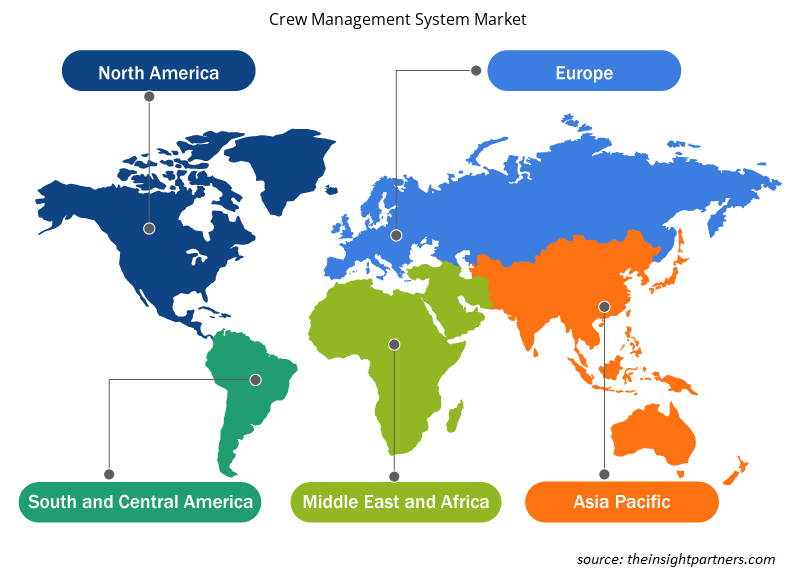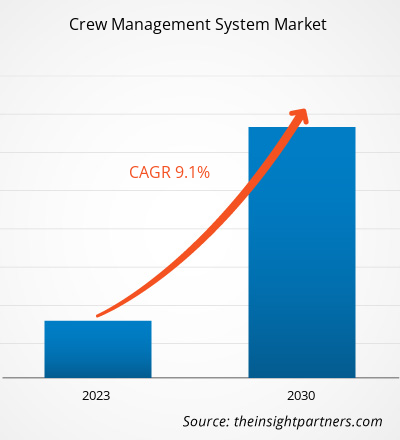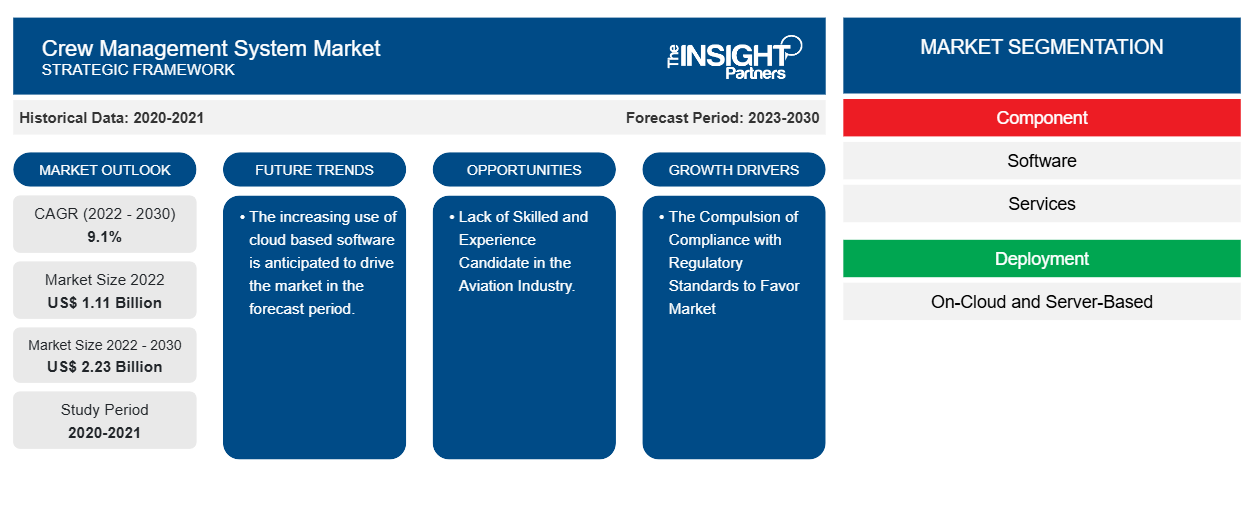من المتوقع أن يصل حجم سوق نظام إدارة الطاقم إلى 2.23 مليار دولار أمريكي بحلول عام 2030 من 1.11 مليار دولار أمريكي في عام 2022. ومن المتوقع أن يسجل السوق معدل نمو سنوي مركب بنسبة 9.1٪ خلال الفترة 2022-2030. ومن المرجح أن يظل النمو السريع لصناعة الطيران والطلب المتزايد على حلول إدارة الطاقم الفعالة من الاتجاهات الرئيسية في السوق.
تحليل سوق نظام إدارة الطاقم
من المتوقع أن ينمو الطلب على سوق أنظمة إدارة الطاقم مع تزايد تفويض الامتثال للمعايير التنظيمية والنمو السريع في صناعة الطيران. بالإضافة إلى ذلك، فإن الطلب المتزايد على حلول إدارة الطاقم الفعّالة يغذي نمو السوق. علاوة على ذلك، فإن عمليات التوسع في الرحلات الطويلة منخفضة التكلفة ونقص المرشحين المهرة وذوي الخبرة في صناعة الطيران توفر فرصًا هائلة للسوق.
نظرة عامة على سوق نظام إدارة الطاقم
يهدف نظام إدارة الطاقم إلى توفير معلومات حول الطاقم في جميع الأوقات. فهو يساعد المستخدم في توفير معلومات حول وجود الطاقم في المحطة الأصلية أو المحطة الخارجية، والحفاظ على سجلات حالتهم وتعيين الطاقم للقطارات. كما يجب أن يحتفظ بالمعلومات المتعلقة بالراحة الدورية وغيرها، والتعلم على الطريق، ومعرفة الجر، وجدول التدريب، وPME، وإجراءات DAR وما إلى ذلك.
قم بتخصيص هذا التقرير ليناسب متطلباتك
ستحصل على تخصيص لأي تقرير - مجانًا - بما في ذلك أجزاء من هذا التقرير، أو تحليل على مستوى الدولة، وحزمة بيانات Excel، بالإضافة إلى الاستفادة من العروض والخصومات الرائعة للشركات الناشئة والجامعات
- احصل على أهم اتجاهات السوق الرئيسية لهذا التقرير.ستتضمن هذه العينة المجانية تحليلاً للبيانات، بدءًا من اتجاهات السوق وحتى التقديرات والتوقعات.
محركات وفرص سوق نظام إدارة الطاقم
ضرورة الالتزام بالمعايير التنظيمية لصالح السوق
إن الأولوية القصوى لشركات الطيران وشركات النقل الجوي الأخرى هي ضمان الامتثال للوائح التشغيل الخاصة بها. يعد جدولة الطاقم جانبًا مهمًا من عملية الامتثال التنظيمي نظرًا للقواعد واللوائح المعقدة الموضوعة لحكم وقت طيران أعضاء الطاقم وحدود الراحة والواجب. يلعب نظام جدولة الطاقم دورًا حاسمًا في تأكيد الامتثال لهذه القوانين من خلال تقليل مخاطر الانتهاكات والعقوبات المرتبطة بها. هناك امتثال أيضًا، ويمكن أن تساعد برامج إدارة الطاقم في ضمان الامتثال للوائح البحرية الدولية ذات الصلة، مثل الاتفاقية الدولية لمعايير التدريب والشهادات والمراقبة (STCW) واتفاقية العمل البحري (MLC). وبالتالي، فإن إجبار الامتثال للمعايير التنظيمية يغذي نمو السوق.
نقص المرشحين ذوي المهارة والخبرة في صناعة الطيران.
إن الافتقار إلى المرشحين المهرة وذوي الخبرة في مجال الطيران يحمل الكثير من الفرص لسوق أنظمة إدارة الطاقم. يتعين على شركات الطيران تعظيم إنتاجية وكفاءة قوتها العاملة الحالية نظرًا لوجود عدد أقل من المرشحين المهرة المتاحين. يمكن أن يساعد نظام إدارة الطاقم في تحسين جداول عمل الطاقم، وضمان الاستفادة من المواهب المتاحة بشكل فعال، وتقليل وقت التوقف، وتحسين الكفاءة التشغيلية الإجمالية. كما أنه يساعد في تعزيز أدوات التدريب والتطوير، وتحسين عمليات التوظيف، والاحتفاظ بالمواهب الحالية، والامتثال وإدارة السلامة، وما إلى ذلك.
تقرير تحليل تجزئة سوق نظام إدارة الطاقم
إن القطاعات الرئيسية التي ساهمت في اشتقاق تحليل سوق نظام إدارة الطاقم هي المكون، والنشر، ونوع شركة الطيران، والتطبيق.
- بناءً على المكون، ينقسم سوق نظام إدارة الطاقم إلى برمجيات وخدمات. ومن المتوقع أن يحظى قطاع البرمجيات بحصة كبيرة في الفترة المتوقعة.
- بناءً على النشر، ينقسم سوق نظام إدارة الطاقم إلى سحابي ومبني على الخادم. ومن المتوقع أن يحظى قطاع السحابي بحصة كبيرة في فترة التنبؤ.
- بناءً على نوع شركة الطيران، يتم تقسيم سوق نظام إدارة الطاقم إلى شركات الطيران للركاب وشركات الشحن والدفاع. ومن المتوقع أن يستحوذ قطاع شركات الطيران للركاب على حصة كبيرة في فترة التوقعات.
- من حيث التطبيق، يتم تقسيم السوق إلى عمليات الطاقم وتدريب الطاقم. ومن المتوقع أن يحظى قطاع عمليات الطاقم بحصة كبيرة في الفترة المتوقعة.
تحليل حصة سوق نظام إدارة الطاقم حسب المنطقة الجغرافية
ينقسم النطاق الجغرافي لتقرير سوق نظام إدارة الطاقم بشكل أساسي إلى خمس مناطق: أمريكا الشمالية، ومنطقة آسيا والمحيط الهادئ، وأوروبا، والشرق الأوسط وأفريقيا، وأمريكا الجنوبية والوسطى.
سيطرت أمريكا الشمالية على سوق أنظمة إدارة الطاقم. ويعزى النمو إلى التقدم التكنولوجي في أمريكا الشمالية. إن دمج التقنيات مثل الذكاء الاصطناعي والتعلم الآلي يزيد من كفاءة ووظائف أنظمة إدارة الطاقم. علاوة على ذلك، فإن التركيز على التحول الرقمي والبحث والتطوير يغذي نمو السوق في أمريكا الشمالية. بالإضافة إلى ذلك، فإن التحول المتزايد نحو الحلول المستندة إلى السحابة والامتثال التنظيمي وكفاءة التشغيل والشراكة الاستراتيجية والاستثمارات يقود سوق برامج إدارة الطاقم.
رؤى إقليمية حول سوق أنظمة إدارة الطاقم
لقد قام المحللون في Insight Partners بشرح الاتجاهات والعوامل الإقليمية المؤثرة على سوق نظام إدارة الطاقم طوال فترة التوقعات بشكل شامل. يناقش هذا القسم أيضًا قطاعات سوق نظام إدارة الطاقم والجغرافيا في جميع أنحاء أمريكا الشمالية وأوروبا ومنطقة آسيا والمحيط الهادئ والشرق الأوسط وأفريقيا وأمريكا الجنوبية والوسطى.

- احصل على البيانات الإقليمية المحددة لسوق نظام إدارة الطاقم
نطاق تقرير سوق نظام إدارة الطاقم
| سمة التقرير | تفاصيل |
|---|---|
| حجم السوق في عام 2022 | 1.11 مليار دولار أمريكي |
| حجم السوق بحلول عام 2030 | 2.23 مليار دولار أمريكي |
| معدل النمو السنوي المركب العالمي (2022 - 2030) | 9.1% |
| البيانات التاريخية | 2020-2021 |
| فترة التنبؤ | 2023-2030 |
| القطاعات المغطاة | حسب المكون
|
| المناطق والدول المغطاة | أمريكا الشمالية
|
| قادة السوق وملفات تعريف الشركات الرئيسية |
|
كثافة اللاعبين في سوق أنظمة إدارة الطاقم: فهم تأثيرها على ديناميكيات الأعمال
يشهد سوق أنظمة إدارة الطاقم نموًا سريعًا، مدفوعًا بالطلب المتزايد من المستخدم النهائي بسبب عوامل مثل تفضيلات المستهلكين المتطورة والتقدم التكنولوجي والوعي الأكبر بفوائد المنتج. ومع ارتفاع الطلب، تعمل الشركات على توسيع عروضها والابتكار لتلبية احتياجات المستهلكين والاستفادة من الاتجاهات الناشئة، مما يؤدي إلى زيادة نمو السوق.
تشير كثافة اللاعبين في السوق إلى توزيع الشركات أو المؤسسات العاملة في سوق أو صناعة معينة. وهي تشير إلى عدد المنافسين (اللاعبين في السوق) الموجودين في مساحة سوق معينة نسبة إلى حجمها أو قيمتها السوقية الإجمالية.
الشركات الرئيسية العاملة في سوق نظام إدارة الطاقم هي:
- شركة ايمز انتل دي دبليو سي ذ.م.م
- ايرباص SE
- شركة أركوس المحدودة
- شركة سي ايه اي
- شركة هيتيت لخدمات الكمبيوتر المحدودة
- شركة آي بي إس للبرمجيات المحدودة
إخلاء المسؤولية : الشركات المذكورة أعلاه ليست مرتبة بأي ترتيب معين.

- احصل على نظرة عامة على أهم اللاعبين الرئيسيين في سوق نظام إدارة الطاقم
أخبار السوق والتطورات الأخيرة حول نظام إدارة الطاقم
يتم تقييم سوق نظام إدارة الطاقم من خلال جمع البيانات النوعية والكمية بعد البحث الأولي والثانوي، والتي تتضمن منشورات الشركات المهمة وبيانات الجمعيات وقواعد البيانات. فيما يلي بعض التطورات في سوق نظام إدارة الطاقم:
- أعلنت الخطوط الجوية الهندية أنها ستطبق قريبًا نظامًا جديدًا لإدارة طاقم العمل من شأنه أن يساعد في تعزيز قواعد تنظيم جدول العمل وتمكين التعافي بشكل أسرع من الاضطرابات المجدولة.
(المصدر: طيران الهند، موقع الشركة الإلكتروني، أبريل 2024)
- أبرمت شركة OSM ومجموعة Ocean Technologies Group شراكة استراتيجية لتوفير التمكين التشغيلي عبر إدارة الأسطول والطاقم والتعلم. ولتعزيز استراتيجيتها الرقمية طويلة الأجل، دخلت شركة إدارة السفن الرائدة OSM في شراكة استراتيجية مع مجموعة Ocean Technologies Group (OTG).
(المصدر: OSM، موقع الشركة، أبريل 2022)
تقرير سوق نظام إدارة الطاقم والتغطية والنتائج المتوقعة
يوفر تقرير "حجم سوق نظام إدارة الطاقم والتوقعات (2020-2030)" تحليلاً مفصلاً للسوق يغطي المجالات التالية:
- حجم سوق نظام إدارة الطاقم وتوقعاته على المستويات العالمية والإقليمية والوطنية لجميع قطاعات السوق الرئيسية التي يغطيها النطاق
- اتجاهات سوق نظام إدارة الطاقم بالإضافة إلى ديناميكيات السوق مثل المحركات والقيود والفرص الرئيسية
- تحليل مفصل لقوى PEST/Porter الخمس وSWOT
- تحليل سوق نظام إدارة الطاقم الذي يغطي اتجاهات السوق الرئيسية والإطار العالمي والإقليمي واللاعبين الرئيسيين واللوائح والتطورات الأخيرة في السوق
- تحليل المشهد الصناعي والمنافسة الذي يغطي تركيز السوق، وتحليل خريطة الحرارة، واللاعبين البارزين، والتطورات الأخيرة لسوق نظام إدارة الطاقم.
- ملفات تعريف الشركة التفصيلية
- التحليل التاريخي (سنتان)، سنة الأساس، التوقعات (7 سنوات) مع معدل النمو السنوي المركب
- تحليل PEST و SWOT
- حجم السوق والقيمة / الحجم - عالمي، إقليمي، بلد
- الصناعة والمنافسة
- مجموعة بيانات إكسل
التقارير الحديثة
تقارير ذات صلة
شهادات العملاء
سبب الشراء
- اتخاذ قرارات مدروسة
- فهم ديناميكيات السوق
- تحليل المنافسة
- رؤى العملاء
- توقعات السوق
- تخفيف المخاطر
- التخطيط الاستراتيجي
- مبررات الاستثمار
- تحديد الأسواق الناشئة
- تحسين استراتيجيات التسويق
- تعزيز الكفاءة التشغيلية
- مواكبة التوجهات التنظيمية





















 احصل على عينة مجانية ل - سوق نظام إدارة الطاقم
احصل على عينة مجانية ل - سوق نظام إدارة الطاقم